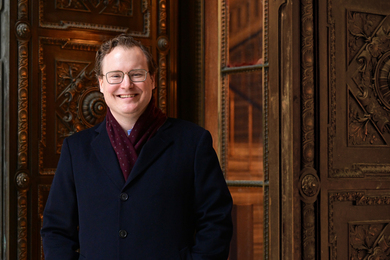Throughout his theater career, Jay Scheib has played many roles — playwright, producer, director, designer, and performer, to name just a few. Now he takes on a singular role as the newly appointed housemaster for the Senior House undergraduate community.
Scheib has been a member of the MIT Music and Theater Arts faculty since 2003, with the occasional visit as guest professor for acting and directing at international conservatories such as the Norwegian Theater Academy in Oslo, Norway, and the Mozarteum in Salzburg, Austria. During that time he has received numerous honors and awards, including MIT’s Edgerton Award for Faculty Achievement in 2008, a prestigious 2011 Guggenheim Fellowship for Creative Arts, and an OBIE Award for best direction. He was also named one of 25 “Artists who will define the next 25 years of American Theater” by American Theater Magazine in April 2009.
With credits ranging from plays to ballet to television to opera, what drew Scheib to becoming a housemaster at Senior House?
“I have always been drawn to Senior House,” he says. “I certainly would have lived there myself had I applied to MIT for university — not that I would have gotten in! The creativity of the community, in step with its tremendous focus, curiosity, rigor, and discipline, is profoundly inspiring. I share very deeply their independent spirit, their daring inventiveness, and especially their social values. It’s an honor and a privilege to be welcomed into the community.”
“Senior House is a small, eclectic community, and the housemaster plays an important role in shaping the residents’ experience,” says Dean for Student Life Chris Colombo. “Jay shares the innovative and creative energy that brings Senior House’s character to life. Combined with his ability to connect with students, Jay’s appointment is a great result for Senior House residents now and in the future.”
John Essigmann, the William R. (1956) and Betsy P. Leitch Professor in Residence of Chemistry, professor of toxicology and biological engineering, and housemaster of Simmons Hall, chaired the search committee, which consisted of another housemaster, faculty, and staff. “Senior House prides itself as a haven for artists on campus,” Essigmann said. “Jay and the students seemed to be on the same wavelength at every stage of the process, which led the committee to the conclusion that he is a good match for this position.”
Scheib replaces Agustín Rayo PhD ’01, associate professor in the Department of Linguistics and Philosophy, and Carmen Saracho, a novelist and restaurant critic. They had been the Senior House housemasters since May 2010.
In addition to Essigmann, the search committee included Rodrigo Lopez Uricoechea ’16 and Adrianna Rodriguez ’16 from Senior House; housemaster Nina Davis-Millis from MIT Librarie; Dean of Engineering Ian Waitz; Professor Robert Redwine; graduate resident tutor Margaret K. Delano; and Division of Student Life staff members Henry Humphreys, Michael Barcelo, and Camille Romney.
MIT housemasters are faculty who reside in the undergraduate and graduate residential halls and fill an important role in each house’s community. Part advisor and advocate, part mentor and neighbor, housemasters work closely with their area director, graduate resident tutors, their house’s student government, and the Division of Student Life to advise students, provide leadership for the house, and foster community life at the Institute.
Opened in 1918, Senior House is the oldest undergraduate residence hall at MIT. According to a history published on its website, Senior House was MIT’s first dormitory and has been home to several communities including MIT’s first on-campus fraternity, undergraduates, graduate students, and even served as military housing during World War II.










